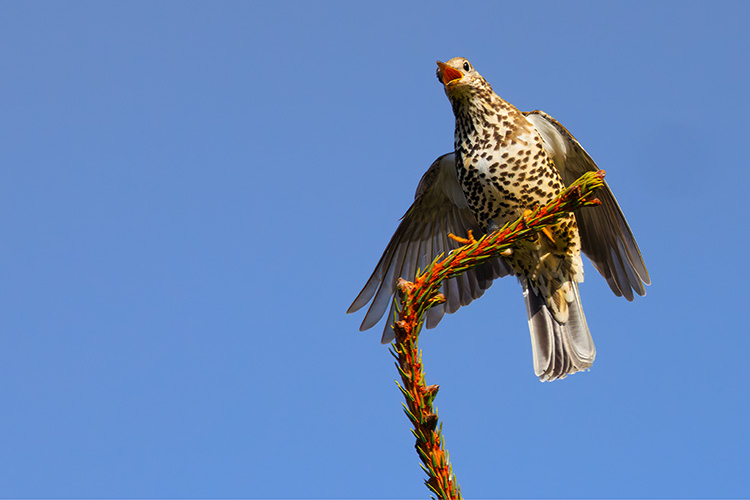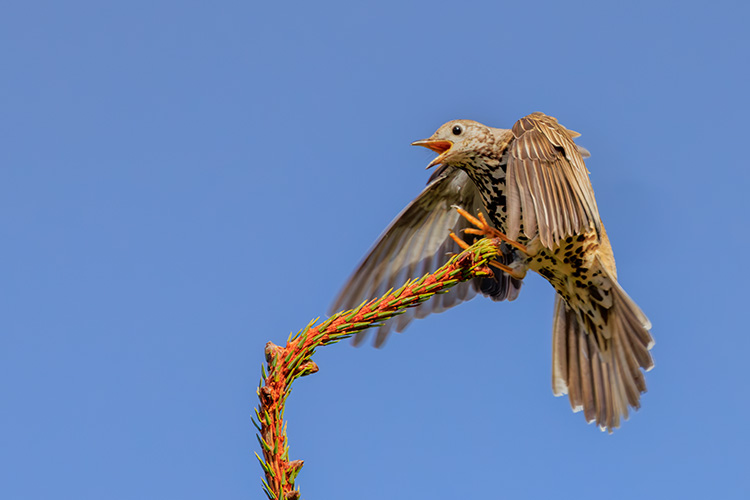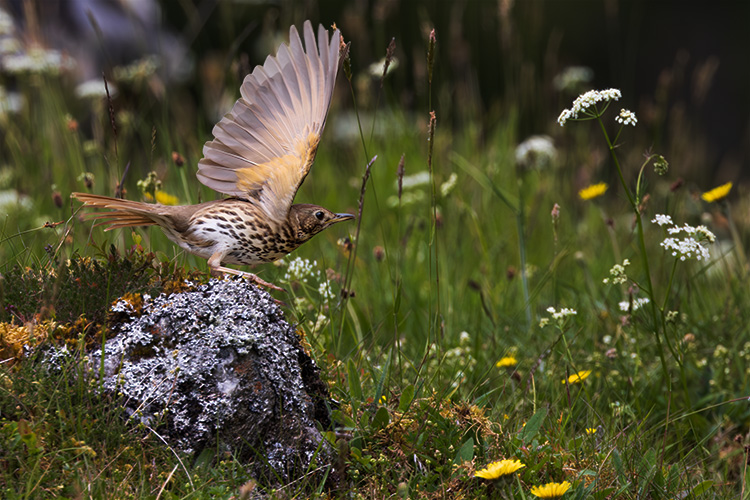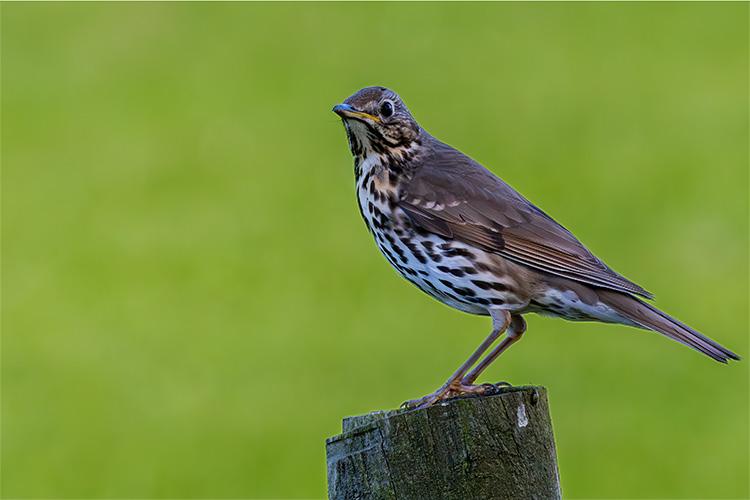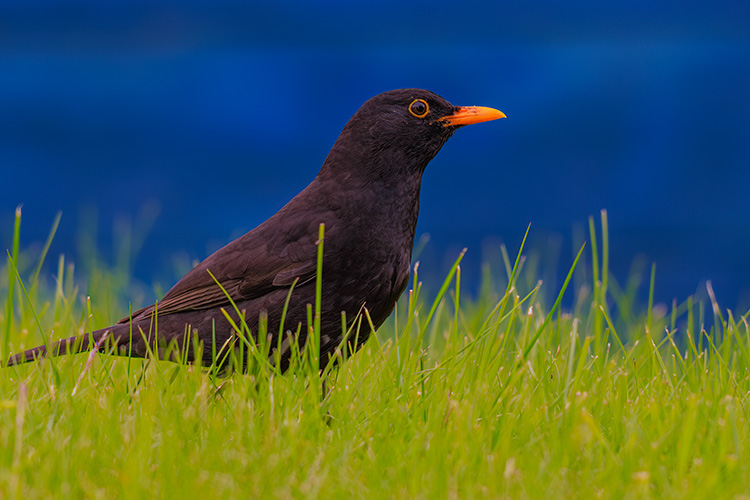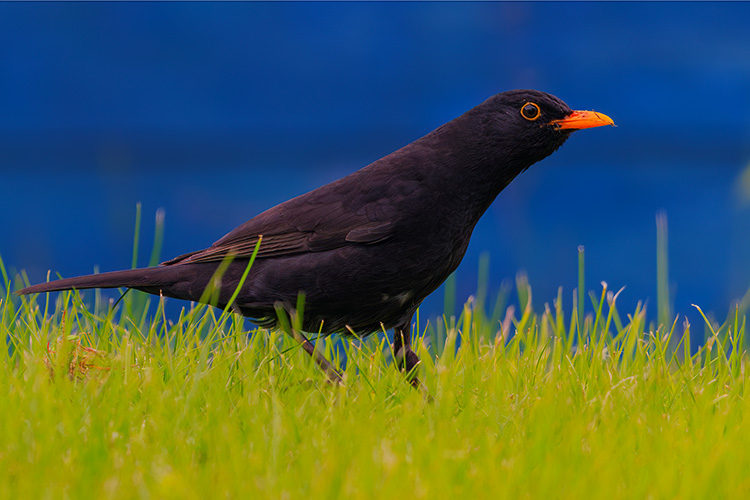
Mistle thrush Turdus viscivorus
Named after the old English name for mistletoe, with 'mistletoe-eater' giving its Latin specific. This rather obvious species accumulated a wide range of regional names over time: Muzzel thrush, Holm thrush, Holm Screech Holm Screech, Mizzly Dick for its love of holly, mistletoe and holm berries. Screech, Squawking Thrush, Jercock, Chercock, Gawthrush, and Horse thrush, were given for its harsh alarm call and Stormcock for its tendency to carry-on singing through bad weather and gales. Wood thrush, Norman thrush, Marble thrush (for its speckled abdomen), Fen thrush, Stone thrush, Throstle cock and Thrice cock were also used, amongst so many others (go read Swainson).
I'll finish this incomplete list with my favourite, 'Big Mavis'. Look I can imagine a bucolic scene, two farmhands leaning on gate in the early evening sun after a hard day's toil, each chewing on a bit of grass if you wish. One turns to the other and say's "That'll be Big Mavis squawking up in that tree again". We've lost so much colour.
Oh, the French apparently believed it could speak seven languages, well they also believed cutting Antoine Lavoisier's head off was a good idea so I cannot speak to this legend's voracity.
I'll finish this incomplete list with my favourite, 'Big Mavis'. Look I can imagine a bucolic scene, two farmhands leaning on gate in the early evening sun after a hard day's toil, each chewing on a bit of grass if you wish. One turns to the other and say's "That'll be Big Mavis squawking up in that tree again". We've lost so much colour.
Oh, the French apparently believed it could speak seven languages, well they also believed cutting Antoine Lavoisier's head off was a good idea so I cannot speak to this legend's voracity.
Display
Imagine, if you can, a thoroughly demented, talentless but totally committed dancer, a football rattle in each hand, aggressively performing the latest creation of a drug-crazed choreographer, and you've got half-way to imagining this Mistle thrushes performance......
..... I don't think I've ever seen a bird so utterly agitated and stressed-out. Sure, they are noted for being aggressively territorial at times, often physically. But this chap was going absolutely ape .... I think something may have been threatening his nest in an adjacent small tree, but I couldn't see anything around ......
... whatever it was this went on for well over 5 minutes, look at his feet, he's actually jumping up and down, arms flapping, and the noise....
... and well, yes, yes, well spotted, I should have video-recorded it, well I didn't. In fact I had to stand in the middle of the road to get these few shots free of clutter. So if you were driving on the B851 at 12.35 on the 16th of April 2024 and had to swerve to avoid some ..... in the middle of the road, that was me !
... and well, yes, yes, well spotted, I should have video-recorded it, well I didn't. In fact I had to stand in the middle of the road to get these few shots free of clutter. So if you were driving on the B851 at 12.35 on the 16th of April 2024 and had to swerve to avoid some ..... in the middle of the road, that was me !
Song Thrush Turdus philomelos
Earlier known as just Throstle, Grey bird or Mavis (see above) before reference to its beautiful clear singing voice gave rise to the current vernacular. This is captured in a poem by the extraordinarily committed carnivore Frank Buckland (1826-1880):
"Knee deep, knee deep, knee deep,
Cherry du, cherry du, cherry du, cherry :
White hat, white hat;
Pretty Joey, pretty Joey, pretty Joey. "
I have no idea what he'd been eating at the time, you could never tell with him, but that isn't a bad mnemonic. Actually, go look up ol' Frank Buckland – we just don't make characters like him any more
"Knee deep, knee deep, knee deep,
Cherry du, cherry du, cherry du, cherry :
White hat, white hat;
Pretty Joey, pretty Joey, pretty Joey. "
I have no idea what he'd been eating at the time, you could never tell with him, but that isn't a bad mnemonic. Actually, go look up ol' Frank Buckland – we just don't make characters like him any more
Armpits
Now look I'm convinced they're not called this on birds, but the colour of the 'armpit' is a good guide to thrush ID when they're flying, white is Mistle thrush or Field-fare, red is, well, a Redwing, and orange, that'll be this one. Thank you for showing us this so clearly.
Song thrush on a stick
Most of the difference between Mistle and Song Thrushes is relative, the former is distinctly larger. But what if only one of them just sits in front of you? A good clue is the shape of the spots on it's breast. Described as distinctively more 'heart-shaped' than on its cousin. Actually, I think they're more spade-shaped, as in cards, not garden tools.
This was one of those moments when, after trying to find the damned thing and stealthily creep up on it in a row of bushes for 5 minutes, it just flew out and perched nicely against a field behind me. Thank you.
This was one of those moments when, after trying to find the damned thing and stealthily creep up on it in a row of bushes for 5 minutes, it just flew out and perched nicely against a field behind me. Thank you.
Blackbird Turdus merula
Known previously as Ousel, Garden Ousel and Ousel cock, as in Shakespeare's:
" Knee The ousel cock, so black of hue,
With orange tawny bill "
Midsummer's Night's Dream, iii.. Yeah it doesn't rhyme does it, but what do I know.
Irish folklore has it that when the Blackbird sings loud and shrill, rain is sure to follow. I mean it rains every ten minutes in Ireland, so they were onto a killer prediction right there.
A beautiful song and bold habit make the Blackbird a favourite in popular culture, what would our countryside and gardens be without them? Please, let's not find out.
" Knee The ousel cock, so black of hue,
With orange tawny bill "
Midsummer's Night's Dream, iii.. Yeah it doesn't rhyme does it, but what do I know.
Irish folklore has it that when the Blackbird sings loud and shrill, rain is sure to follow. I mean it rains every ten minutes in Ireland, so they were onto a killer prediction right there.
A beautiful song and bold habit make the Blackbird a favourite in popular culture, what would our countryside and gardens be without them? Please, let's not find out.
on the prowl
As such a ubiquitous bird getting a few snaps isn't hard, but how to take a 'pretty picture' of one, for a website say?
Fortunately, while strolling through Farr one day, in the merry merry month ofMay June I noticed this chap pausing for a moment in the sun, against a colourful, blue-stained shed. The bright green grass, looking like it had been given a good dose of nitrogen recently, provided a second bright colour, and my problem was solved.
Fortunately, while strolling through Farr one day, in the merry merry month of
